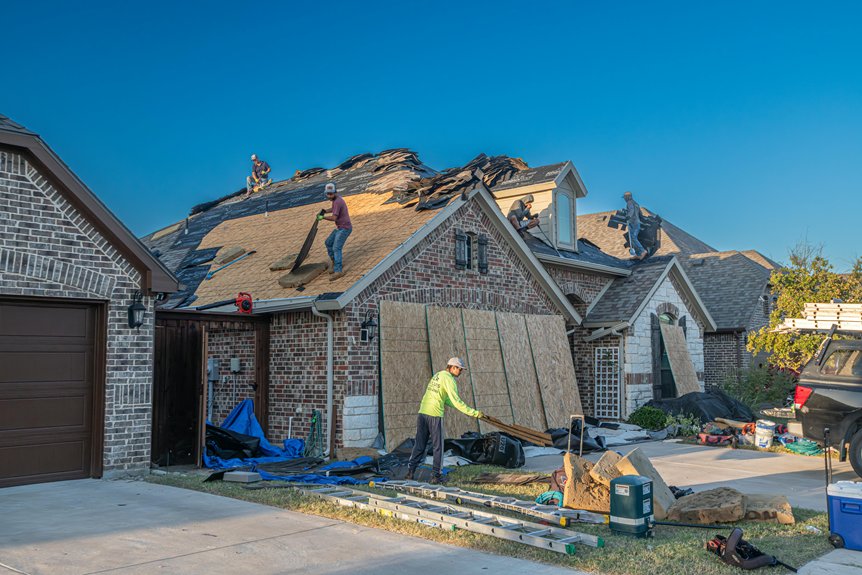When your roof sustains damage, you need a clear strategy to navigate insurance claims efficiently. You’ll want to assess the extent of harm carefully, document everything with precision, and understand your policy’s specific coverage. Timing your claim and selecting the right contractor also play vital roles. Missing any of these steps can delay your settlement or reduce your payout, so it’s important to approach each phase methodically before moving forward.
Assessing Roof Damage Accurately
Before you file a roof insurance claim, you need to assess the damage accurately to avoid disputes and delays.
Begin with a thorough roof inspection, focusing on visible signs like missing shingles, cracked tiles, or water stains. Use a checklist to systematically evaluate every section, noting the extent and nature of the damage.
Consider both immediate issues and potential underlying concerns, such as compromised flashing or structural weaknesses. This detailed damage assessment helps you present clear, objective information to your insurer, strengthening your claim’s validity.
If you’re unsure about certain damage types, consult a professional for an expert roof inspection. Accurate documentation at this stage reduces the likelihood of claim denials or prolonged processing times, ensuring your roof insurance claim proceeds smoothly and efficiently. For expert guidance and assistance, contacting Top View Roofing’s experienced staff can help provide a free inspection and professional opinion before filing your claim.
Documenting Evidence for Your Claim
While evaluating roof damage lays the groundwork, meticulously documenting evidence solidifies your claim’s credibility.
Start by capturing clear photographic evidence from multiple angles, focusing on all visible damage areas. Use a high-resolution camera or smartphone to guarantee details like cracked shingles or water stains are unmistakable.
Next, supplement photos with written documentation—note dates, times, weather conditions, and any immediate repairs made. Create a detailed inventory of damaged materials and estimate repair costs if possible.
Keep all receipts and correspondence related to temporary fixes or inspections. This organized approach guarantees your claim withstands insurer scrutiny and expedites processing.
Understanding Your Insurance Policy Coverage
Because understanding your insurance policy coverage determines the scope of your claim, you need to thoroughly review your policy documents.
Start by identifying the policy types you hold—whether actual cash value, replacement cost, or others—as they dictate how your claim payout is calculated.
Next, examine your coverage limits carefully to know the maximum amount your insurer will pay for roof repairs or replacement.
Pay attention to any exclusions or deductibles that might affect your reimbursement. Understanding these elements helps you set realistic expectations and avoid surprises during the claims process.
If any terms or conditions seem unclear, consult your insurance agent for clarification.
This analytical approach guarantees you leverage your coverage effectively when filing a roof insurance claim.
Timing Your Claim Submission Strategically
Submitting your roof insurance claim promptly after damage occurs can greatly influence the outcome of your reimbursement. You need to be aware of claim deadlines set by your insurer; missing these can result in denial. Carefully review your policy’s timeframe requirements and act quickly.
Seasonal considerations also play a critical role. For example, filing during Piedmont’s wetter months might delay inspections or repairs, impacting claim processing times. Conversely, submitting claims during dry seasons can facilitate faster assessments and repairs, potentially improving your claim experience.
Choosing a Reliable Roofing Contractor
Choosing a reliable roofing contractor greatly affects the success of your insurance claim and the quality of repairs. Start by verifying contractor qualifications, including proper licensing, insurance, and local Piedmont certifications. These guarantee compliance with regional building codes and protect you from liability.
Request detailed estimates that specify materials and labor costs, and confirm whether the contractor offers roofing warranties covering both workmanship and materials. Warranties provide long-term assurance and can influence insurance adjusters’ assessments.
Check references and past project quality to gauge reliability and professionalism. Avoid contractors who pressure you into quick decisions or demand large upfront payments.
Communicating Effectively With Your Insurance Adjuster
How can you guarantee your communication with an insurance adjuster strengthens your roof insurance claim? First, maintain clear, consistent adjuster communication by documenting all interactions—dates, times, and key points discussed. This record supports effective negotiation by providing evidence if discrepancies arise.
Approach conversations with specific questions and factual information about your roof’s condition and repairs needed. Avoid emotional appeals; instead, present objective data such as contractor estimates and photos. Listening carefully to the adjuster’s perspective helps you address their concerns directly.
Being punctual and professional in all communications demonstrates your seriousness and can positively influence claim outcomes. By focusing on clarity and accuracy, you’ll build credibility that’s essential for effective negotiation and ultimately securing a fair insurance settlement.
Preparing for Possible Claim Denial or Disputes
Although you’ve prepared thoroughly, insurance claims can still face denial or disputes. To navigate this, familiarize yourself with claim negotiation strategies that emphasize clear documentation and factual evidence.
Keep detailed records of all communications and repair estimates to support your position. When disputes arise, employ dispute resolution techniques such as mediation or arbitration, which offer structured processes to resolve disagreements without litigation.
Stay objective, focusing on policy terms and damage assessments rather than emotions. Understanding your policy’s fine print helps anticipate coverage limits and exclusions, strengthening your negotiation stance.
Being proactive and informed enables you to respond promptly and effectively, increasing the likelihood of a favorable outcome. Preparing in this way guarantees you’re equipped to handle setbacks methodically and assertively.
Conclusion
By thoroughly evaluating your roof damage and documenting clear evidence, you strengthen your insurance claim’s foundation. Understanding your policy’s specifics guarantees realistic expectations, while timely submission helps avoid delays or denials. Choosing a qualified roofing contractor ensures quality repairs, and effective communication with your adjuster keeps the process transparent. Preparing for possible disputes lets you respond proactively. Following these steps will help you navigate your Piedmont roof insurance claim with confidence and precision. For more information on how to schedule your free roof inspection, call us at (405) 543-2920 or visit us online at Top View Roofing.











